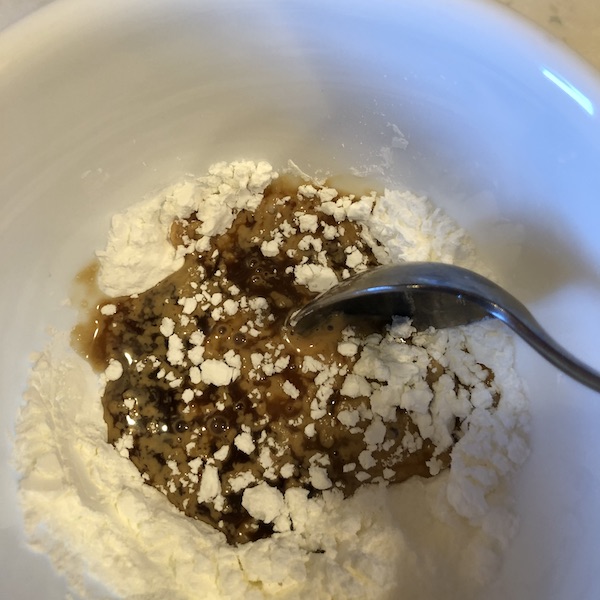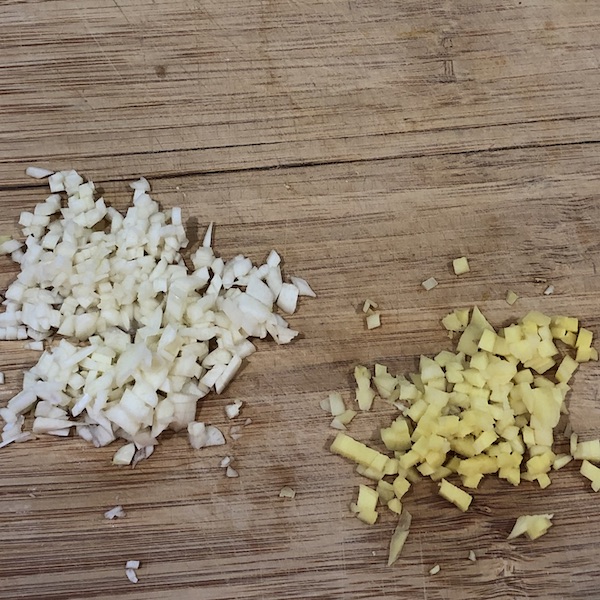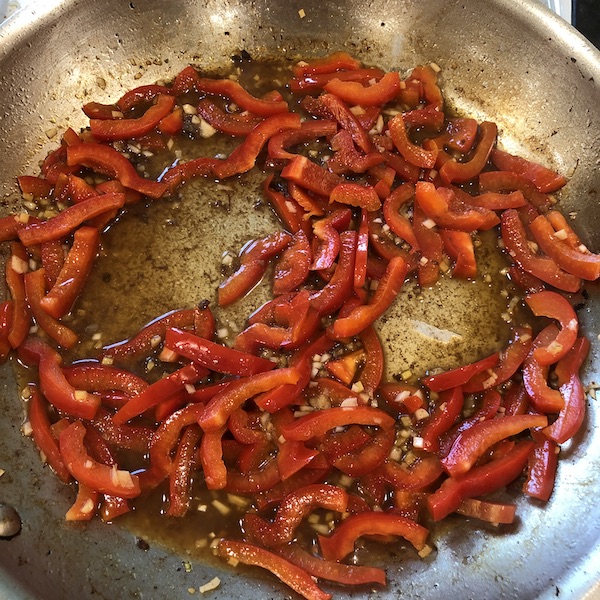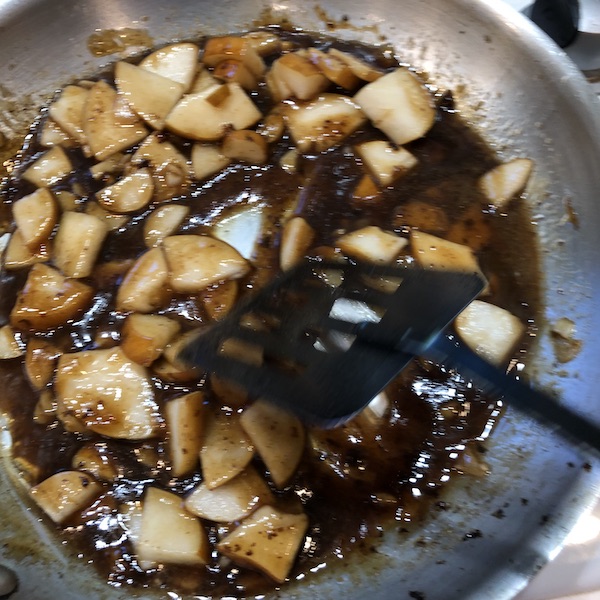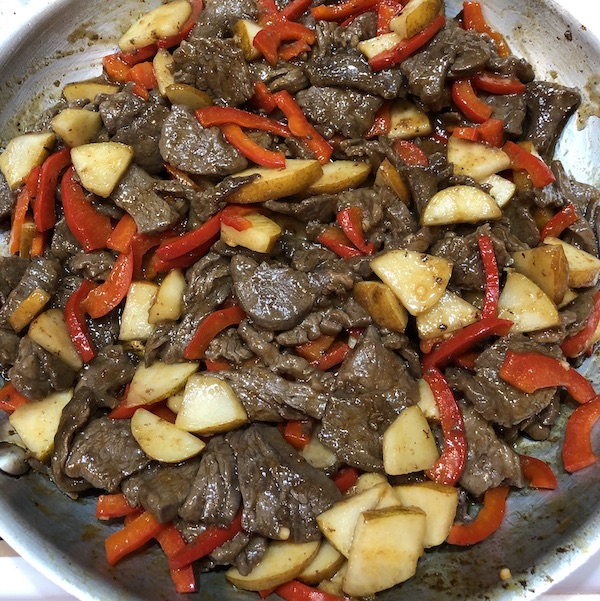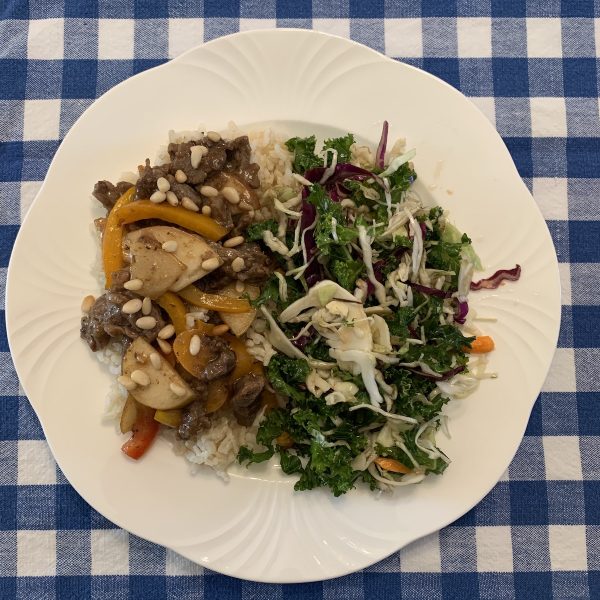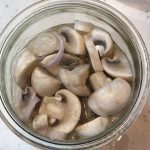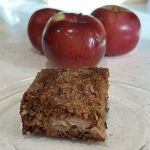Those of you who are gluten free – do you miss Asian food? Those of you who are soy free, do you miss Chinese take out?? What about those of you who avoid msg?
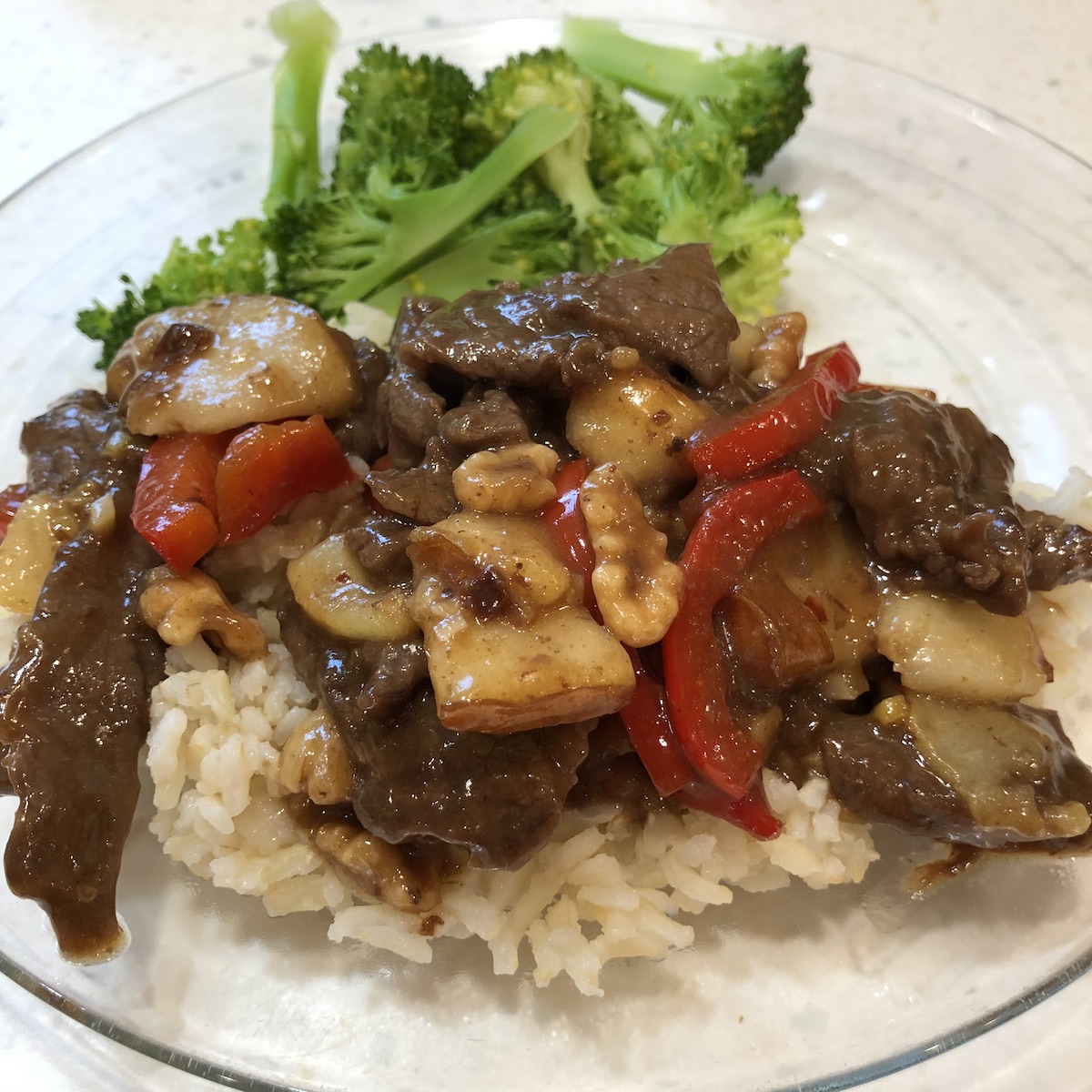
Virtually all Chinese food and other Asian food uses soy sauce which has both soy and wheat in it. You can purchase alternatives but they are too expensive or specialized for most Chinese restaurants to use them. And even if they did you would have to worry about cross contamination which is an issue if you have celiac or an actual gluten or soy allergy (not just a sensitivity or intolerance).
No Wheat, No Soy, No MSG
If I want Asian food, I have to make it. So for the past 20 plus years I have made stirfry. I am going to share with you both my technique and a recipe with variations. While I sometimes miss the convenience of Chinese take out, I do NOT miss the flavor.
I also have a confession. I am always trying to get you to eat more vegetables. They are SO good for you. Add as many vegetables as you want to this stirfry, but I confess that I eat most of my vegetables on the side. I actually like them better that way and more importantly I have enough sauce to completely cover my meat and rice.

My stirfry contains an usual ingredient
Most of my stirfries contain a firm pear. My husband and I ate at a Chinese restaurant in California with a group of friends more than 30 years ago. The chef served a dish I have never forgotten – stirfried beef with sweet red peppers, pear and walnuts. It was the best stirfry I had ever eaten. Now, most of my stirfries are my version of that recipe.
Stiryfry is work – chopping and cutting and cooking. And other than meat preparation, it is NOT make ahead. So if I am going to make it, I am going to eat my favorite version of it.
But you can modify this recipe – however you like! Use about 3 cups vegetables to 1 pound of meat. And I like to add something crunchy at the end. If you cannot eat nuts, I find that pine nuts (which are seeds, not nuts, despite their name) delicious. Or you could try water chestnuts for crunch.
You can find recipes that are easier. But I think they taste mediocre at best. This is an AMAZING stirfry – no soy, no wheat and no msg.

Let’s talk about ingredients and then we will talk about technique.
Ingredients
Coconut Aminos – The first ingredient we have to talk about is how to replace the soy sauce. Soy adds umami – a savory flavor that is hard to replicate. MSG also enhances this flavor profile. Between my husband’s intolerance to soy and my son’s migraines, I had to find another alternative.
Now if you are just avoiding wheat and not soy, you can use tamari which is essentially soy sauce without wheat.
Several years ago I turned to my FaceBook friends for soy sauce alternatives and many of them recommended coconut aminos. I had never tried them. They were a clear winner over the other soy sauce alternatives I tried.
Coconut aminos tend to be sweeter and less salty than soy sauce. So if your stirfry tastes a bit flat, put the salt shaker on the table. That way everyone can add salt to their taste. I have tried a variety of brands and they have all been good. So use whatever your grocery store has in stock.
I have tried a variety of other soy sauce alternatives over the years. Right now I have a bottle of “no soy, soy free sauce” in my fridge. It had a promising list of ingredients: water, sea salt, organic molasses, lime juice with mushrooms (and kelp) attempting to provide umami. It was promising, but not a hit in our household. So I was back to the coconut aminos.
For those of you who cannot eat coconut aminos, and I know some migraine sufferers cannot, I have version of a sauce that will work for you also. It is a little different, but still good.
Beef – cut into thin strips across the grain – about 1/8 inch thick. (I find tenderloin is perfect when I find it on sale. I have used a variety of beef over the years, sirloin is a common choice.
Pork can also be used.
Red Peppers – or any sweet pepper. I use a large one or one and a half medium or two small ones. I like the interest that the red color gives, but all taste delicious.
Pear – I use a firm pear, usually a bosc variety. Feel free to substitute any vegetables here – about three cups total (for the pear and peppers)
garlic – try onions or shallots if you cannot eat garlic
fresh ginger – omit if you cannot tolerate

Marinade
- coconut aminos – I have used a variety of brands and they add a dimension that is hard to get without them. However if you cannot eat them, skip marinating the meat and sprinkle with salt about 15-30 minutes before cooking.
- sugar – just a teaspoon to aid browning – but feel free to omit if you would like.
- cornstarch – also helps with browning and helps marinade stick to meat. Use tapioca starch if you avoid corn. I have found that arrowroot starch tends to be slimy in stirfry.
- oil – use whatever liquid oil with a high smoke point and mild flavor your family tolerates
Sauce
I have three variations on sauces. The first is my favorite. However if you cannot tolerate coconut aminos, try another variation. Or try one for a change. They are flexible. Mix and match them to your family’s tastes. But don’t skip the fond (pan brownings/drippings) in the sauce. It will give a depth of flavor that is hard to replicate without msg or soy. It takes your stirfry from mediocre to a “yum.” See below for preparation for how to prepare the pan drippings.

Sauce 1
- 3 tablespoons sherry – I keep mine in the refrigerator for a very long time and it works just fine in this recipe! You can use a Chinese or Japanese rice wine as well.
- 2 tablespoons coconut aminos
- 2 tablespoons sugar
- 1 teaspoon toasted sesame oil
- 4 teaspoons corn starch
- pan drippings and water
Sauce 2
- 3 tablespoon sherry
- 2 tablespoons plum sauce (read ingredients carefully) I have also used a mild flavored jam here or cooked plums
- 2 tablespoons coconut aminos
- 1 teaspoon sesame oil
- 4 teaspoons starch for thickening
- pan drippings and water
No amino sauce
- 2 tablespoons rice vinegar
- 2 tablespoons sugar (or other sweetener)
- 2 tablespoons rice wine (Sake)
- 1 teaspoon sesame oil
- 4 teaspoons starch for thickening
- pan drippings
If you cannot eat sesame, just omit the sesame oil.
Like it spicy?
There are so many ways to add spice to this recipe! You can add a chili oil or sriracha with the sesame oil in the sauce. Or you can add cayenne. Use jalapenos or other spicy peppers with the red peppers. This recipe is so easy to modify for different tastes!
Preparation
Two techniques are important for this stirfry: cooking your meat and ingredient preparation.
No wok??!!??!!
To build flavor in your stirfy without soy or msg, give up your wok.
I learned this years ago from Cook’s Illustrated. They suggested using a 12 inch stainless steel skillet for stirfry. The fond that develops (the brown part that develops and stays on the pan when the meat is cooked) adds depth of flavor to the dish.
To develop fond will take a few extra minutes because the meat will have to be cooked in batches. And your hands will have to be washed several times so the raw meat on your hands does not contaminate everything else. But is it worth it.
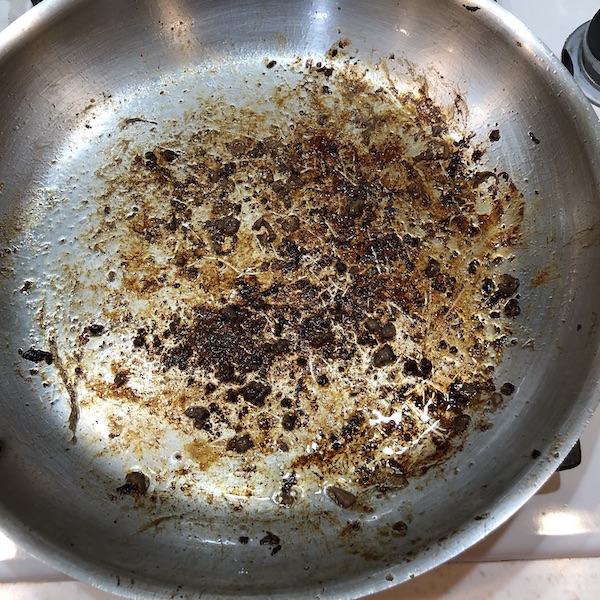
Here are the detailed steps
Heat 1 tablespoon oil in a stainless steel frying pan over medium heat. Do not use non-stick. The fond that develops when cooking the meat will flavor the sauce and it will not develop properly in nonstick.
When you put the meat to cook, start some (a cup or so) water heating in a tea kettle or small saucepan. When it boils, turn it off until you are ready to use it.
Place the meat in a single layer in the pan, leaving some space around each piece. It will take about 3 batches to cook all the meat. By the time you have washed your hands after handling raw meat, it is ready to start turning the meat. Start turning the meat you put in the frying pan first.
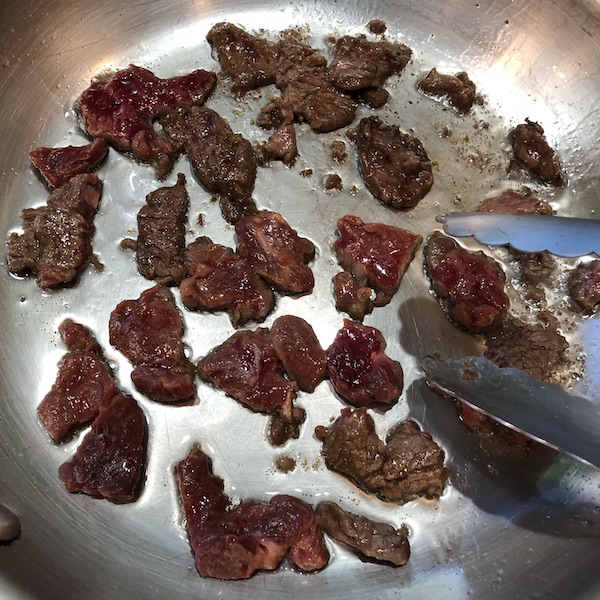
When you turn the meat, it should have developed several dark brown spots on each piece. It should not just be evenly light brown. Some parts of your frying pan may be hotter than others so every piece does not have to have browned parts, but most should. If none of the pieces have browned spots let the meat cook a little longer (too long will make the meat tough though!)
Flip the meat with a metal spatula or a fork. I use a spatula to scrape up the pieces that stick to the pan. By the time I am through flipping the pieces, it is almost time to remove the first pieces. Again, they should have a few dark brown spots on them. Remove them to the serving bowl.
If the bottom of your frying pan is domed like mine is, you may need to swirl the oil before placing the second batch of meat in a single layer in the pan. By the time you have finished washing your hands, it is time to start flipping the pieces over.
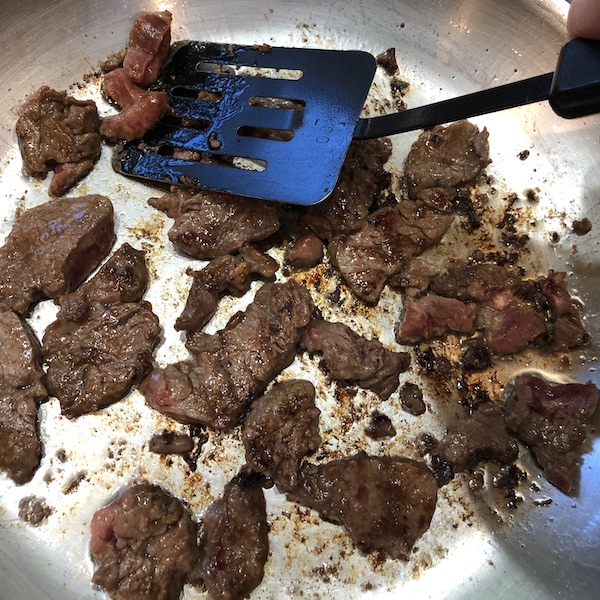 By now your pan should be starting to develop a dark brown layer in spots – this is exactly what you want. It helps your meat brown more quickly and will add flavor. If they appear to be burning, your pan is too hot, turn it down to medium low. You may not have enough meat to cover the pan bottom the third time, so be sure to cover the browner spots first.
By now your pan should be starting to develop a dark brown layer in spots – this is exactly what you want. It helps your meat brown more quickly and will add flavor. If they appear to be burning, your pan is too hot, turn it down to medium low. You may not have enough meat to cover the pan bottom the third time, so be sure to cover the browner spots first.
When all your meat is cooked and in the bowl, pour about 1/2 – 1 cup of the water that has boiled into the hot pan. Cover the bottom of the pan. It will steam up – be careful you do not burn yourself.
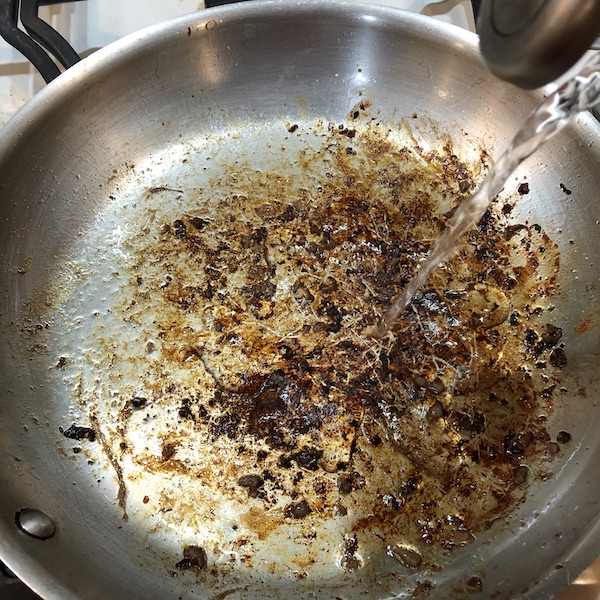
Let the water boil about a minute. Then take your metal spatula and scrape all the brown pieces (fond) from the bottom of the pan. This will take a couple of minutes. If it looks like more than about 1/2 cup of liquid, let some of the water boil away. Pour the brown liquid (it should have small chunks of brown in it – that is ok) into a small heat resistant bowl while you stirfry the other vegetables.
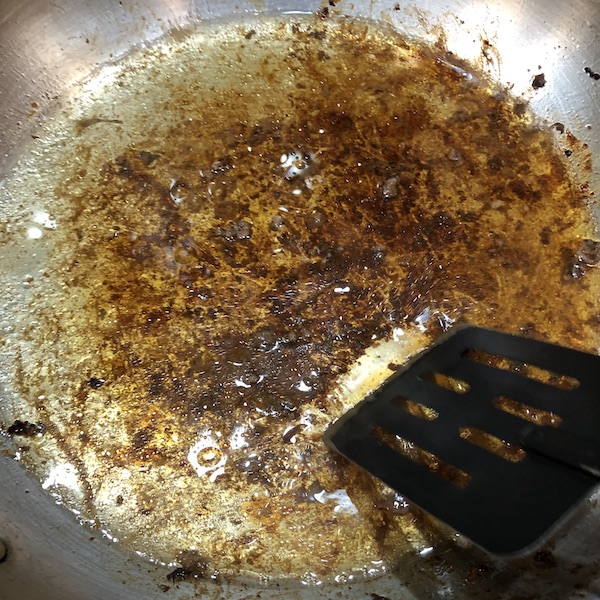
Cut and mix ahead
The second technique for stirfry is to have ALL your ingredients and sauces and other parts of dinner ready before you begin to cook the stirfry. It will take all your time and attention so everything must be ready to go.
Some of the preparation can be done ahead – I prepare my meat ahead and freeze it in a thin package so it thaws quickly. Peppers and most vegetables can be cut the day before. Even the sauce can be made the day ahead if necessary.
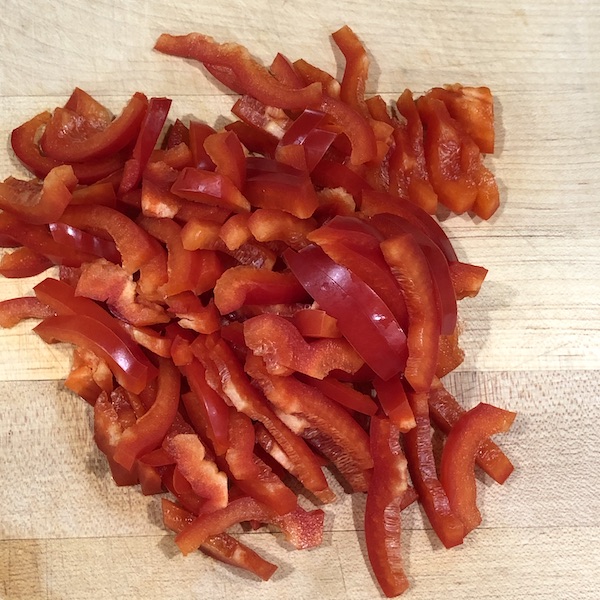
Cooking things in stages allows them to cook more evenly without overcooking the faster cooking items.
To finish the dish
After you cook the meat and deglaze the pan (remove the fond with water) you have a pan that is not very clean. That is just fine. Add one half to 1 tablespoon oil and saute your red pepper until tender crisp. Just before removing it from the pan, add the chopped garlic and ginger. Cook about 30 seconds, stirring very frequently. Empty the skillet on top of the cooked meat. Check to be sure there is a thin coating of oil on the pan. Place the pears in the pan to warm. After about 30 seconds, add the sauce. Stir frequently so the sauce thickens evenly. Add the meat and other vegetables to warm. Stir to coat all with sauce. You may wish to cover the pan to heat more quickly, but it will take just a couple of minutes over low heat to warm everything.

Serve over brown rice. Enjoy!
This is not a quick and easy dish. It takes some time in preparation and standing over the stove. There are some oil splatters to clean up. But good things come to those who work hard! You will not miss Chinese take out again! Enjoy!
Leave me a comment and let me know what you think! Have you ever tried pear in your stirfy before? What changes did you make? What would you try next time?
Have you made a “goldilocks” or “just right” gluten free / soy free stir fry yet? Share your observations to encourage others.
Listen to The Sensitive Kitchen podcast episode 051 where Cindy walks you through this recipe. Listen for more great recipes for your food sensitive family.

Gluten Free Stir Fry without Soy
Equipment
- 12 inch stainless steel frying pan
- metal spatula
- whisk
Ingredients
- 1 pound lean beef, cut into thin strips across the grain - about 1/8 inch thick
- 1 large red or other colored sweet pepper, cut into strips (instructions below)
- 1 firm bosc pear, cut thinly into bite size pieces
- 2-3 cloves garlic, minced
- ½-1 tablespoons ginger, minced
- 1½ tablespoons oil
- ½ cup coarsely broken walnuts, pine nuts, water chestnuts (sliced)
Marinade
- 4 teaspoons tapioca flour or corn starch
- 1 teaspoon sugar
- 2 tablespoons coconut aminos *
- 1 tablespoon oil
Sauce option #1
- 3 tablespoons sherry **
- 2 tablespoons coconut aminos
- 2 tablespoons sugar or other sweetener
- 4 teaspoons tapioca flour or corn starch
- 1 teaspoon toasted sesame oil ***
- drippings from pan with about ½ - ¾ cup water
Sauce option #2
- 3 tablespoon sherry**
- 2 tablespoons plum sauce ****
- 2 tablespoons coconut aminos
- 4 teaspoons tapioca flour or corn starch
- 1 teaspoon toasted sesame oil ***
- drippings from pan with about ½ - ¾ cup water
Sauce option #3 - no coconut aminos
- 2 tablespoon rice vinegar
- 2 tablespoon sugar or other sweetener
- 2 tablespoons sake (Chinese / Japanese wine) can use sherry
- 4 teaspoon tapioca flour or corn starch
- 1 tespoon toasted sesame oil ***
- drippings from pan with about ½ - ¾ cup water
Instructions
- Prepare marinade. Mix starch and sugar in small bowl. (easier to mix everything this way.) Add coconut aminos and mix thoroughly. Add oil and whisk to combine. It is ok if the oil does not combine completely. When you add it to the meat and smush it around, it will mix in.

- Prepare your meat. Place in a bag or bowl with marinade. Turn several times so all meat is coated with marinade. Let marinate while you prep other ingredients, turning the bag a couple of times to be sure all meat is coated. If your meat has been frozen, use a paper towel to absorb all excess moisture until meat is dry, then marinate.
- Mince garlic so the allicin has a chance to develop (for more listen to The Sensitive Kitchen podcast episode ). Mince ginger.

- Rinse and core pepper. Cut the pepper from stem end to blossom end into about 6-8 pieces. Cut each piece crosswise into thin strips, about ⅛-¼ inches thick. Strips should be about 1½-2 inches long (& fit in your mouth without cutting).

- Prepare the sauce. Stir sugar to dissolve in liquids. Add starch and whisk to combine. Add toasted sesame oil.

- Break the walnuts or other nuts. Leave pinenuts whole if you are using them. If using water chestnuts, drain and pat dry.
- Cut the pear last so it has less time to turn brown. Working from the stem end, cut off the stem and slice the skinny end in half (about 2 inches up the pear or so.) Cut into thin slices, about ⅛ inch thick. When the pear is thicker, cut into quarters and slice. When the long neck is sliced, cut the remaining pear into quarters and core. Cut each quarter into ⅛ in thick pieces, cutting the thickest ones in half.
- Heat 1 tablespoon oil in a stainless steel frying pan***** over medium heat. Do not use non-stick. The fond that develops when cooking the meat will flavor the sauce.
- When you put the meat to cook, start some water heating in a tea kettle or small saucepan. When it boils, turn it off until you are ready to use it.
- Place the meat in a single layer in the pan, leaving some space around each piece. It will take about 3 batches to cook all the meat. By the time you have washed your hands after handling rqw meat, it is ready to start turning the meat. Start with the meat you put in the frying pan first.

- When you turn the meat, it should have developed several dark brown spots on each piece. (Some parts of your frying pan may be hotter than others so every piece does not have to have browned parts, but most should). If none of the pieces have browned spots, but are just light brown, let the meat cook a little longer (too long will make your meat tough!)
- Flip the meat with a metal spatula or a fork. I use a spatula on the pieces that stick to the pan. By the time I am through flipping the pieces, it is usually time to remove the pieces that were flipped first. Again, they should have a few dark brown spots on them. Remove them to the serving bowl. Adjust your heat accordingly - the meat should brown, if it is not, turn up the heat. If it is browning too fast - before you can flip the pieces, turn it down a bit.

- If your frying pan is domed like mine is, you may need to swirl the oil before placing the second batch of meat in a single layer in the pan. By the time you have finished washing your hands, it is time to start flipping the pieces over.
- By now your pan should be starting to develop a dark brown layer in spots - this is fine. It helps your meat brown more quickly and will add flavor. You may not have enough meat to cover the pan bottom the third time, so be sure to cover the browner spots first.

- When all your meat is cooked and in the bowl, pour about 1/2 - 3/4 cup of the water that has boiled into the hot pan. It will steam up - be careful you do not burn yourself.

- Let the water boil for a minute. Then take your metal spatula and scrape all the brown pieces (fond) from the bottom of the pan. This will take a couple of minutes. If it looks like more than about 1/2 cup of liquid, let some of the water boil away. Pour the brown liquid (it should have small chunks of brown in it - that is normal) into a small heat resistant bowl while you stirfry the other vegetables.

- Put 1/2 to 1 tablespoon oil in the pan. Add the peppers and cook for about 2 minutes, stirring occasionally. Make a hole in the middle and add the garlic and ginger. Cook for about 30 seconds until the garlic is fragrant. Place pepper slices, garlic and ginger on top of the meat.

- Be sure there is a thin coating of oil in the pan. Add the pear slices to the pan to warm them a little, about 30 seconds.
- Add the the reserved water and meat drippings. Stir. Add the sauce and stir.

- The sauce will thicken as it comes to a boil. Stir frequently until it is slightly thickened. Add the meat and peppers and stir to coat with sauce and warm. Cook for about 1 minute and add nuts / pinenuts (or you can put them on at the table.

- Serve immediately over brown rice. Enjoy!

Notes
- * or Chinese / Japanese rice wine, sake
- ** If you are not using coconut aminos, sprinkle meat with 1/2 to 1 teaspoon salt half an hour before stir fying. (see blog post for more details)
- *** omit sesame oil if sensitive
- **** can also use jelly, cooked plums (see blog post for more details)
- ***** Can use saute pan - when I make more than one recipe, I use a 6 quart saute pan. Can also use cast iron.

